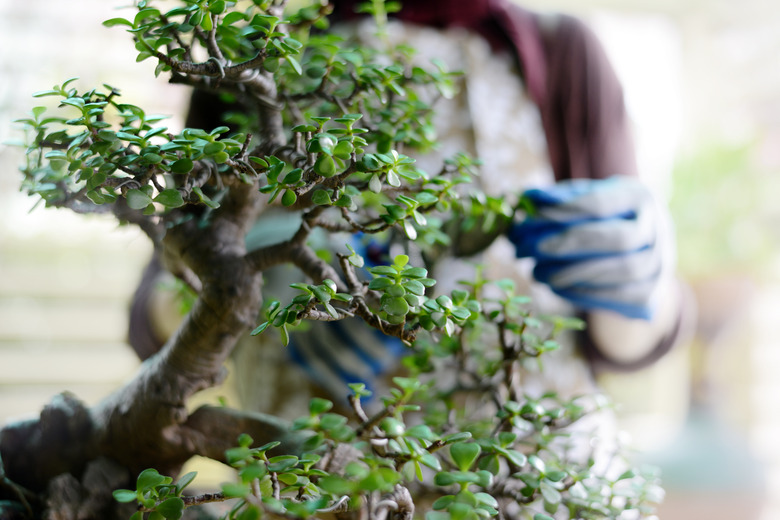How To Grow Bonsai Trees Fast
Growing bonsai trees is known as a practice of patience, but what if you want to grow bonsai trees fast? While there's no shortcut to speed up the process unnaturally, choosing a fast-growing tree species and providing ideal growing conditions can help your tree thrive. Following certain care tasks, such as trimming roots, repotting regularly and fertilizing your bonsai tree, can also help it grow quickly.
Choose a Fast-Growing Species
Choose a Fast-Growing Species
Bonsai is a specific way of growing a tree, not a species itself. You can create this living art form with a variety of tree species, including deciduous, evergreen, coniferous and succulent plants. Choosing a tree variety that grows quickly can help move your bonsai project along faster. Some fast-growing species to consider include weeping willow (Salix babylonica, zones 6-8), red maple (Acer rubrum, zones 2-9), Chinese juniper (Juniperus chinensis, zones 4-9) and American boxwood (Buxus sempervirens, zones 5-8).
Use a Starter Tree
Use a Starter Tree
You can start your bonsai tree from seed, but it adds a lot of time to the process. When started from seeds, bonsai trees can take four or more years just to reach the point where you can start shaping it. Choosing a nursery stock tree gives you a head start on growing the tree so you can get to shaping and creating your living artwork quicker. Another method is starting your bonsai tree from a cutting taken from a parent tree in the species you want.
Provide Ideal Growing Conditions
Provide Ideal Growing Conditions
Ideal growing conditions help any plant grow faster, including a bonsai tree. If the tree lacks the sunlight, soil and temperature that it prefers, its growth will slow. The specific growing conditions for a bonsai tree depend on the species you choose.
Ensure you're providing the amount and type of light your tree prefers. Some bonsai tree species prefer direct light, while others like bright, indirect light. Pot it using the type of soil it prefers, which should be well-draining to prevent root damage. Some species also need humidity to grow well, so you might need to use a water-filled pebble tray or mist the tree.
Feed and Water Consistently
Feed and Water Consistently
Along with proper growing conditions, bonsai trees need consistent moisture and fertilizer to help with growth. Too much water can cause root rot, which can slow growth and eventually kill the tree. Too little water also slows the tree's growth, slowing down the bonsai process. Specific species requirements dictate how often you water your bonsai tree. Look for signs of underwatering or overwatering, which usually show up in the leaves.
Fertilizer provides nutrients to encourage the tree to grow, which is important since nutrients are limited in the pot-growing environment. Specific fertilizer requirements vary by tree species. In general, use a balanced water-soluble fertilizer applied weekly or every few weeks during the active growing season, usually from spring to late summer. In the winter, reduce your fertilizing schedule to once per month for some species and none at all for other species. Follow the fertilizer instructions precisely to avoid harming your tree.
Prune Bonsai Tree Roots
Prune Bonsai Tree Roots
Pruning the tree's roots encourages them to regenerate for stronger, faster growth and prevents the pot from becoming overwhelmed with roots. The best time to prune the roots is during the slower growing season in late fall or early spring.
Lots of small, thin roots are ideal because they're able to soak up water and nutrients well. Use alcohol-wiped pruning shears to trim the large roots first. Trim roots from all around the tree, removing enough roots for the tree to fit well into the pot without being root-bound. Avoid removing more than two-thirds of the roots to minimize shock to the tree. Repot the tree in fresh soil and water thoroughly.
Repot Your Bonsai
Repot Your Bonsai
Regular repotting gives your bonsai enough space to continue growing. Many trees need to be repotted every two years, but the species and rate of growth can affect that timing. Faster-growing trees might need to be repotted yearly. You can use a larger pot, but pruning the roots when you repot allows you to continue using the same container. With fewer roots, the tree still fits in the old pot with plenty of room to absorb nutrients.
Repot your bonsai late in the winter while it's still dormant to reduce shock to the tree. The important part of repotting is renewing the growing medium. Use fresh potting mix to ensure the proper soil pH and lots of nutrients. Old soil can have a buildup of minerals and salt that affect the tree's growth.
References
- Bonsai Empire: The Basics: Learn How to Grow a Bonsai Tree
- Arborist Now: A Beginner's Guide to Bonsai Trees
- Bonsai Outlet: Keeping Your Bonsai Healthy With Root Pruning
- Missouri Botanical Garden: Salix babylonica
- Missouri Botanical Garden: Acer rubrum
- Missouri Botanical Garden: Crassula ovata
- NC State Extension: Juniperus chinensis
- Missouri Botanical Garden: Buxus sempervirens
